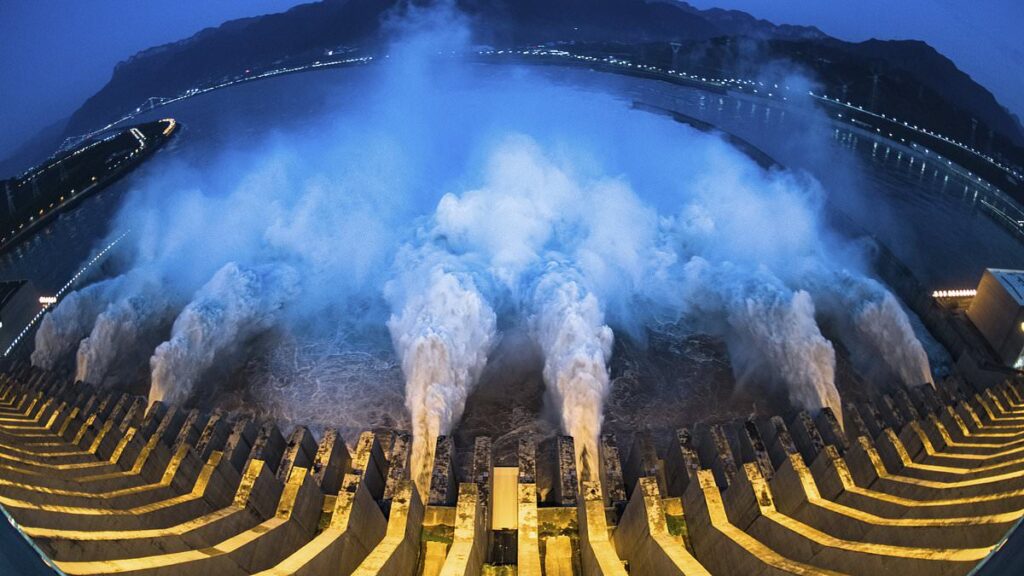
China has embarked on the construction of what is set to become the world’s largest dam, the Motuo Hydropower Station, a project that has raised significant concerns among its neighbors, India and Bangladesh. The construction, officially launched by Chinese Premier Li Qiang in a remote Tibetan village, is being hailed by Beijing as the “project of the century.” However, Indian officials have expressed fears that the dam could be used as a “hydrowarfare weapon,” potentially threatening regional stability.
The dam, located on the Yarlung Zangpo river, is expected to generate 300 billion kilowatt hours of electricity annually, more than three times the output of the current world leader, the Three Gorges Dam. This ambitious project comes with a hefty price tag of approximately 1.2 trillion yuan (£124 billion). While China touts the dam as a key component of its goal to achieve net zero emissions by 2060, its downstream neighbors are wary of the potential consequences.
Regional Concerns and Potential Impacts
The Yarlung Zangpo river flows into India and Bangladesh, forming vital waterways such as the Siang, Brahmaputra, and Jamuna rivers. These rivers are crucial for the livelihoods of millions in one of the world’s most fertile and densely populated regions. Indian and Bangladeshi officials have raised alarms that the new dam could allow China to control water flow, potentially leading to severe droughts or catastrophic floods.
Arunachal Pradesh Chief Minister Pema Khandu has been vocal about the risks, describing the dam as an “existential threat” to local communities. He warned that the project could significantly reduce water levels in the Siang and Brahmaputra rivers, posing a direct threat to agriculture and human life. “The issue is that China cannot be trusted,” Khandu remarked, highlighting fears that Beijing could use the dam as a “water bomb” in times of conflict.
China’s Position and Regional Tensions
China has dismissed these concerns, asserting its “legitimate right” to develop the Yarlung Zangpo. The Chinese foreign ministry has emphasized that the dam will not harm downstream nations and has promised to maintain communication channels for disaster prevention. However, India remains skeptical, having lodged formal complaints and initiated defensive measures, such as the Siang Upper Multipurpose Project, to mitigate potential flooding risks.
Neither China nor India is a signatory to the UN Water Convention, which governs the management of transboundary water resources. This absence of a legal framework complicates the situation, as Beijing is not obligated to ensure adequate water flow to downstream countries. India, with its burgeoning population and limited freshwater resources, views the control of water as a critical issue.
Historical Context and Strategic Implications
The strategic use of water resources is not new in the region. In April, following a terrorist attack in Pahalgam, India suspended its participation in the Indus Waters Treaty with Pakistan, highlighting the potential for water to be used as a geopolitical tool. This move, while carrying significant risks, underscores the importance of water in regional security dynamics.
Experts like Dr. Manali Kumar of the University of St. Gallen warn that the weaponization of water resources sets a dangerous precedent. “This also sets a dangerous precedent for the weaponisation of shared resources,” she noted, emphasizing the need for robust international frameworks to address such issues.
Environmental and Social Concerns
Beyond geopolitical tensions, the environmental and social impacts of China’s dam projects are significant. The construction of the Three Gorges Dam, for example, displaced 1.4 million people and caused substantial ecological changes. Similar outcomes are feared for the Motuo Hydropower Station, with potential displacement of local populations and disruption of the region’s rich cultural heritage.
Environmental policy specialist Tempa Gyaltsen Zamlha from the Tibet Policy Institute has expressed concerns about ecological destruction and forced migration. “Many local residents would be forced to leave their ancestral homes,” he said, warning of the long-term impacts on the region’s biodiversity.
Brian Eyler, director of the energy, water, and sustainability program at the Stimson Center, also highlighted the potential ecological consequences, noting that the dam could block fish migration and sediment flow, essential for soil fertility downstream.
Looking Ahead
As construction progresses, the Motuo Hydropower Station remains a focal point of regional tension. The project exemplifies the complex interplay between development, environmental stewardship, and geopolitical strategy. The international community faces a pressing need to address the potential for water to be used as a weapon, advocating for legal frameworks that prevent the manipulation of shared resources.
Meanwhile, the stakes continue to rise as both China and India navigate the delicate balance of resource management and regional security. The outcome of this situation could set a precedent for future transboundary water disputes, highlighting the critical importance of cooperative management and diplomatic engagement in addressing shared environmental challenges.





